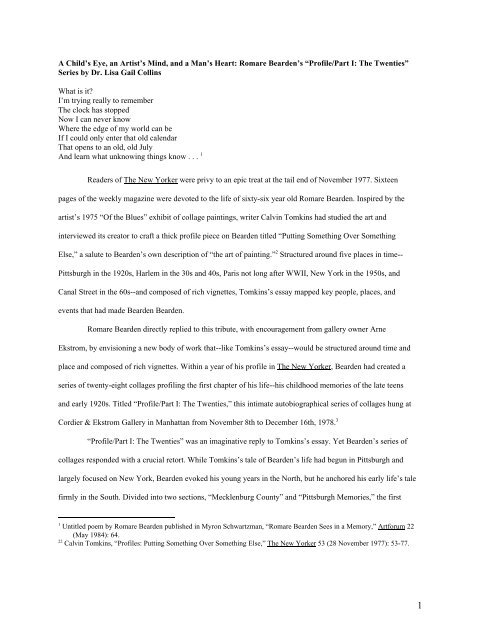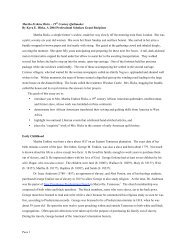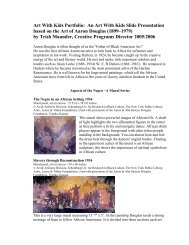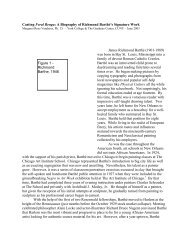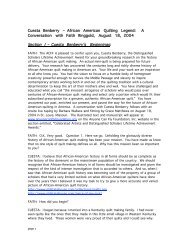A Child's Eye, an Artist's Mind, and a Man's Heart: Romare Bearden's
A Child's Eye, an Artist's Mind, and a Man's Heart: Romare Bearden's
A Child's Eye, an Artist's Mind, and a Man's Heart: Romare Bearden's
You also want an ePaper? Increase the reach of your titles
YUMPU automatically turns print PDFs into web optimized ePapers that Google loves.
section includes twenty-four collages while the second includes four. Memories of largely rural MecklenburgCounty, North Carolina dominate the series. When asked by literary scholar Charles Rowell about his closeidentification with the South, which was the site of his birth <strong>an</strong>d some summers, but not his primary childhoodresidence, Bearden explained: “The South happens to be where I was born, <strong>an</strong>d I think the memories areindelible. There could be other places, but for me it is Mecklenburg County.” 4In 1978, from his C<strong>an</strong>al Street home <strong>an</strong>d his Long Isl<strong>an</strong>d City studio, the sixty-six year old artistw<strong>an</strong>dered his mind back to Mecklenburg County, North Carolina <strong>an</strong>d, secondarily, Pittsburgh, Pennsylv<strong>an</strong>ia<strong>an</strong>d tr<strong>an</strong>slated his vital memories through collage to create his series of childhood recollections. Collage, amethod <strong>an</strong>d medium well suited for expressing the layers, edges, <strong>an</strong>d hues of remembr<strong>an</strong>ce was also, as RalphEllison suggests, <strong>an</strong> art form fit for Bearden’s desire to keep his youthful memories whole <strong>an</strong>d true. Of this,Ellison wrote:Bearden seems to have told himself that in order to possess the me<strong>an</strong>ing of his southernchildhood <strong>an</strong>d northern upbringing, that in order to keep his memories, dreams <strong>an</strong>d valueswhole, he would have to recreate them, hum<strong>an</strong>ize them by reducing them to artistic style. 5Figure 1 – Maudell Sleet’s Magic GardenOne tale Bearden evoked in his series was his memory of a wom<strong>an</strong> named Maudell Sleet. As <strong>an</strong> adult,he remembered a widowed wom<strong>an</strong> who had vali<strong>an</strong>tly run a farm <strong>an</strong>d exquisitely tended a garden by herself. Healso remembered that, as a child, he had seen this wom<strong>an</strong> as infused with a magical exuber<strong>an</strong>ce due to her greenthumb <strong>an</strong>d her generous offerings of just picked fruit. H<strong>an</strong>dwritten text accomp<strong>an</strong>ying the collage reads: “I c<strong>an</strong>still smell the flowers she used to give us <strong>an</strong>d still taste the blackberries.” Titled Maudell Sleet’s Magic Garden(Figure 1), this vibr<strong>an</strong>t collage vividly suggests Bearden’s warm childhood memory of fecundity <strong>an</strong>dabund<strong>an</strong>ce. Smaller th<strong>an</strong> a sheet of paper, the collage is intimate in size <strong>an</strong>d monumental in color. Rich reds,or<strong>an</strong>ges, yellows, <strong>an</strong>d greens form the lush layered world that the gifted gardener enlivens. The wom<strong>an</strong>, attunedto her gorgeous h<strong>an</strong>diwork <strong>an</strong>d radi<strong>an</strong>t with its bounty, strikingly resembles Alice Walker’s 1974 memory ofher own mother <strong>an</strong>d her garden. In her classic essay “In Search of Our Mothers’ Gardens”--written four yearsbefore Bearden’s exhibit--Walker reminisced about her mother:I notice that it is only when my mother is working in her flowers that she is radi<strong>an</strong>t, almost tothe point of being invisible--except as Creator: h<strong>an</strong>d <strong>an</strong>d eye. She is involved in work her soulmust have. Ordering the universe in the image of her personal conception of Beauty. 63 <strong>Romare</strong> Bearden most likely saw “Profile/Part I: The Twenties” as the first of a decade-by-decade survey his life’srecollections. In 1981, he exhibited a second chapter, a series of nineteen collages, titled “Profile/Part II: The Thirties”at Cordier & Ekstrom Gallery.4 Quoted in Charles H. Rowell, “‘Inscription at the City of Brass’: An Interview with <strong>Romare</strong> Bearden,” Callaloo 36(Summer 1988): 430.5 Ralph Ellison, “Introduction,” in <strong>Romare</strong> Bearden: Paintings <strong>an</strong>d Projections (Alb<strong>an</strong>y, NY: The Art Gallery at the StateUniversity of New York, 1968), unpaginated.2
scenes of domestic life with their associations of purity <strong>an</strong>d cle<strong>an</strong>sing, so we might be reminded that tenderlyperforming the <strong>an</strong>cient rites of everyday life c<strong>an</strong> invite the divine.While silence <strong>an</strong>d stillness saturate this collage, Bearden was also <strong>an</strong> aficionado of music <strong>an</strong>d sound.Trains, with all their implied noise, charge through the artist’s work. Symbols of progress, adventure, hope, <strong>an</strong>dencroachment, Bearden called trains “journeying things” <strong>an</strong>d succinctly explained their import<strong>an</strong>ce: “Trains areso much a part of Negro life. Negroes lived near the tracks, worked on the railroads, <strong>an</strong>d trains carried themNorth during the migration.” 10 The artist’s childhood memories are ripe with locomotive lore. His greatgr<strong>an</strong>dparentslived near the busy Charlotte, North Carolina tracks <strong>an</strong>d he fondly remembered his greatgr<strong>an</strong>dfathertaking him to watch the trains <strong>an</strong>d imagine their passengers <strong>an</strong>d cargo. Bearden reveled in thesounds of the train--its pitched whistle, pulsing rhythm, low hiss, <strong>an</strong>d loud roar--<strong>an</strong>d dreamed of running one.Figure 3 – Daybreak ExpressFour collages in “Profile/Part I: The Twenties” feature trains. Titled after a Duke Ellington song,Daybreak Express (Figure 3) shows a black wom<strong>an</strong> asleep in a Matisse-worthy room while a train outside herwide-open window plows by. Here the energy <strong>an</strong>d dynamism of the train heading north contrasts with thel<strong>an</strong>guid nature of the slumbering wom<strong>an</strong> facing south. Head atop a plump patchwork pillow, the feminine nudelies in opposition to the charging masculine train. Belying the bal<strong>an</strong>ce <strong>an</strong>d order of its composition, the collagereveals a clash of opposites: feminine <strong>an</strong>d masculine, nature <strong>an</strong>d culture, interior <strong>an</strong>d exterior, tradition <strong>an</strong>dch<strong>an</strong>ge. Train intruding on her solo sleep--<strong>an</strong>d with no suitcase in sight--the wom<strong>an</strong> embodies cultural theoristHazel Carby’s crucial point that “Migration for women often me<strong>an</strong>t being left behind.” 11When Bearden’s series hung at Cordier & Ekstrom Gallery in early winter 1978, each of his collageswas accomp<strong>an</strong>ied by text written directly onto the gallery wall. The fruits of collaboration with writer AlbertMurray, who also edited the titles of the collages, the texts were spare narrative statements that grew fromconversations between the two men. Accomp<strong>an</strong>ying Daybreak Express, in Bearden’s h<strong>an</strong>dwriting, were thewords: “You could tell not only what train it was but also who the engineer was by the sound of the whistle.”Bearden’s interest in working in series, matching individual works with legends, <strong>an</strong>d visualizing the trains so10 Quoted in Tomkins, “Putting Something Over Something Else,” 74.11 Hazel V. Carby, “It Jus Be’s Dat Way Sometime: The Sexual Politics of Women’s Blues,” Radical America 20:4 (June-July 1986): 15.4
central to Afric<strong>an</strong> Americ<strong>an</strong> life visibly echoes the work of his friend <strong>an</strong>d colleague Jacob Lawrence (1917-2000), particularly Lawrence’s “The Migration of the Negro” series of 1941. Composed of sixty smallpaintings--each accomp<strong>an</strong>ied by spare <strong>an</strong>d suggestive text--Lawrence’s series chronicles the mass movement ofAfric<strong>an</strong> Americ<strong>an</strong>s from the rural South to the urb<strong>an</strong> North through figurative painting <strong>an</strong>d social sciencele<strong>an</strong>ingtext. Bearden’s series, which combines collage <strong>an</strong>d more personal text, creatively converses withLawrence’s acclaimed work. As the two men were friends <strong>an</strong>d working in studios one floor apart on Harlem’s125th Street when Lawrence was completing his series, it is likely that Jacob Lawrence’s work served as <strong>an</strong>inspiration for Bearden’s autobiographical epic.The sixty paintings that make up Lawrence’s “The Migration of the Negro” series c<strong>an</strong> be divided intothree groups: images that depict the South, images that depict trains <strong>an</strong>d the act of migrating, <strong>an</strong>d images thatdepict the North. The twenty-eight images that comprise Bearden’s series c<strong>an</strong> be similarly ordered: twenty ofthe collages suggest the South, four collages, while <strong>an</strong>chored in the South, reveal trains <strong>an</strong>d their associationswith movement <strong>an</strong>d migration, <strong>an</strong>d four evoke the North. The final four collages in Bearden’s series focus onthe artist’s memories of his formative times in Pittsburgh where he spent some summers <strong>an</strong>d completed highschool while living with his maternal gr<strong>an</strong>dmother. Accomp<strong>an</strong>ied by the text: “The mills went 24 hours a daywith three 8-hour shifts,” the first collage of the closing “Pittsburgh Memories” quartet suggests the fate ofsouthern men who hopped northbound trains.Titled Mill H<strong>an</strong>d’s Lunch Bucket (Figure 4), this Pittsburgh-based collage evokes the world of theboarding house Bearden’s gr<strong>an</strong>dmother <strong>an</strong>d her husb<strong>an</strong>d r<strong>an</strong> for migr<strong>an</strong>ts new to their steel mill neighborhood.Denser <strong>an</strong>d drabber th<strong>an</strong> Bearden’s southern compositions, this interior scene shows a threesome (perhaps ayoung Bearden with his gr<strong>an</strong>dmother <strong>an</strong>d step-gr<strong>an</strong>dfather) centered around a table <strong>an</strong>d under pictures, possibly,of kin. On one side, a young worker descends the stairs with arm outstretched <strong>an</strong>d large brown h<strong>an</strong>d ready tograb his waiting lunch bucket. Me<strong>an</strong>while, out the window, the fiery factory with its smoke, heat, <strong>an</strong>d noiseominously awaits the m<strong>an</strong> who is likely new to a strictly punctual <strong>an</strong>d unforgiving clock. Alit by the factoryfire, the st<strong>an</strong>ding wom<strong>an</strong>’s expression befits Bearden’s memory of boarders’ first encounters with the brutalfactory furnace: “They didn’t realize, when they first started, the terrific heat from those furnaces. They’d strip5
to the waist, <strong>an</strong>d when the furnace doors opened, the flames would lick out like evil tongues <strong>an</strong>d scorch them,”he recalled. 12Figure 4 – Mill H<strong>an</strong>d’s Lunch BucketOne story Bearden frequently told of his life was that a vulnerable <strong>an</strong>d unpopular boy, the son of aprostitute, had taught him how to draw. The story goes that one summer day in Pittsburgh while teenagedBearden was living with his gr<strong>an</strong>dmother, the boy, Eugene Bailey, had shown Bearden some drawings he haddone of the brothel where his mother labored. Impressed <strong>an</strong>d excited by his new friend’s drawings as well astheir forbidden subject matter, Bearden exclaimed: “You did this? C<strong>an</strong> you teach me to do it?” 13 Soon after, atBearden’s gr<strong>an</strong>dmother’s insistence, Eugene <strong>an</strong>d his pet birds moved in with the family. Within the year,however, Eugene had tragically passed away. The final collage in Bearden’s “Pittsburgh Memories” quartet <strong>an</strong>dthe closing collage of his series relates young Eugene’s funeral.Titled Farewell Eugene (Figure 5), this dense collage reveals a crowd of mourners gathered under afull hot sun, heads bowed in grief as they st<strong>an</strong>d around a casket crowned with red flowers <strong>an</strong>d the brown earthprepared to house it. Accomp<strong>an</strong>ying text reads: “The sporting people were allowed to come but they had tost<strong>an</strong>d on the far right,” suggesting that even communal <strong>an</strong>guish requires harsh separations. Yet life <strong>an</strong>d hope arealso present in this composition, as the casket rests beneath a tree, a symbol of life, <strong>an</strong>d white birds circle thesky. Perhaps the pigeons <strong>an</strong>d doves Eugene had taken under his wing, the released birds serve as symbols offreedom <strong>an</strong>d hope. Bearden called birds, like trains, “journeying things,” <strong>an</strong>d the free-flying birds suggest thedeceased’s graceful ascent to heaven from earth.Figure 5 – Pittsburgh Memories: Farewell EugeneIn addition to creating this elegiac collage, Bearden also wrote a poem honoring Eugene Bailey’smemory. A passage reads:Nothing like this was necessary,EugeneI st<strong>an</strong>d here among these tombs,holding this flowerwhich will fall endlessly into thisopen earth12 Quoted in Tomkins, “Putting Something Over Something Else,” 54.13 Ibid.6
that rejects nothing. 14This poem with its vision of layering, of petals accumulating in dug earth, lyrically evokes the essenceof Bearden’s intimate autobiographical series of 1978. During his interview with Calvin Tomkins, Beardendescribed “the art of painting” as “putting something over something else.” This description of painting astextured <strong>an</strong>d layered also eloquently describes the art of collage <strong>an</strong>d the act of memory. Layering cut <strong>an</strong>d tornpaper over cut <strong>an</strong>d torn paper to reveal something new mimics the process of remembr<strong>an</strong>ce, where we createsomething new out of accumulated memories we c<strong>an</strong>not forget <strong>an</strong>d those we wish to remember. Tenderlyworking with layers of memory <strong>an</strong>d materials, <strong>an</strong>d wielding scissors, glue, paper, <strong>an</strong>d paint, <strong>Romare</strong> Beardencut <strong>an</strong>d paste himself whole by intimately drawing from his childhood memories, his artist’s mind, <strong>an</strong>d hism<strong>an</strong>’s heart.***********Works Cited:Bearden, <strong>Romare</strong>. Profile/Part I: The Twenties. Picture titles <strong>an</strong>d text reviewed <strong>an</strong>d edited by Albert Murray. NY: Cordier &Ekstrom, 1978.Carby, Hazel V. “It Jus Be’s Dat Way Sometime: The Sexual Politics of Women’s Blues.” Radical America 20:4 (June-July1986): 9-22.Ellison, Ralph. “Introduction.” In <strong>Romare</strong> Bearden: Paintings <strong>an</strong>d Projections. Alb<strong>an</strong>y, NY: The Art Gallery at the StateUniversity of New York, 1968.<strong>Romare</strong> Bearden, 1911-1988: A Memorial Exhibition. NY: ACA Galleries, 1989.<strong>Romare</strong> Bearden: Origins <strong>an</strong>d Progressions. Detroit, MI: Detroit Institute of Arts, 1986.Rowell, Charles H. “’Inscription at the City of Brass’: An Interview with <strong>Romare</strong> Bearden.” Callaloo 36 (Summer 1988):428-446.Schwartzm<strong>an</strong>, Myron. “<strong>Romare</strong> Bearden Sees in a Memory.” Artforum 22 (May 1984): 64-70.Tomkins, Calvin. “Profiles: Putting Something Over Something Else.” The New Yorker 53 (28 November 1977): 53-77.Walker, Alice. In Search of Our Mothers’ Gardens. NY: Harcourt Brace, 1983.************List of Figures:Fig. 1: Maudell Sleet’s Magic Garden from “Profile/Part I: The Twenties,” 1978. Collage on board, 10 1/8 x 7 inches.Private collection.Fig. 2: Miss Mamie Singleton’s Quilt from “Profile/Part I: The Twenties,” 1978. Collage on board, 29 x 41 inches. Privatecollection.Fig. 3: Daybreak Express from “Profile/Part I: The Twenties,” 1978. Collage on board, 10 x 15 inches. Private collection.Fig. 4: Mill H<strong>an</strong>d’s Lunch Bucket from “Profile/Part I: The Twenties,” 1978. Collage on board, 13 3/4 x 18 1/8 inches.Private collection.Fig. 5: Farewell Eugene from “Profile/Part I: The Twenties,” 1978. Collage of various papers with paint, ink, graphite, <strong>an</strong>dbleached areas on fiberboard, 16 1/4 x 20 1/2 inches. Private collection.14 Untitled poem by <strong>Romare</strong> Bearden published in <strong>Romare</strong> Bearden, 1911-1988: A Memorial Exhibition (NY: ACAGalleries, 1989), 30-31.7


